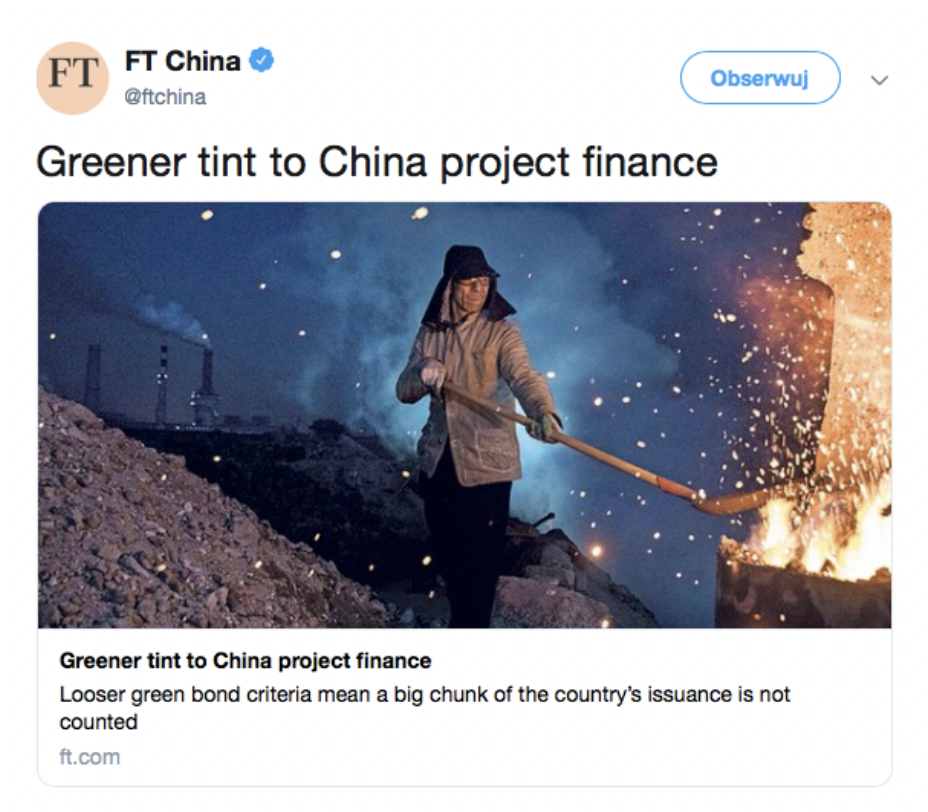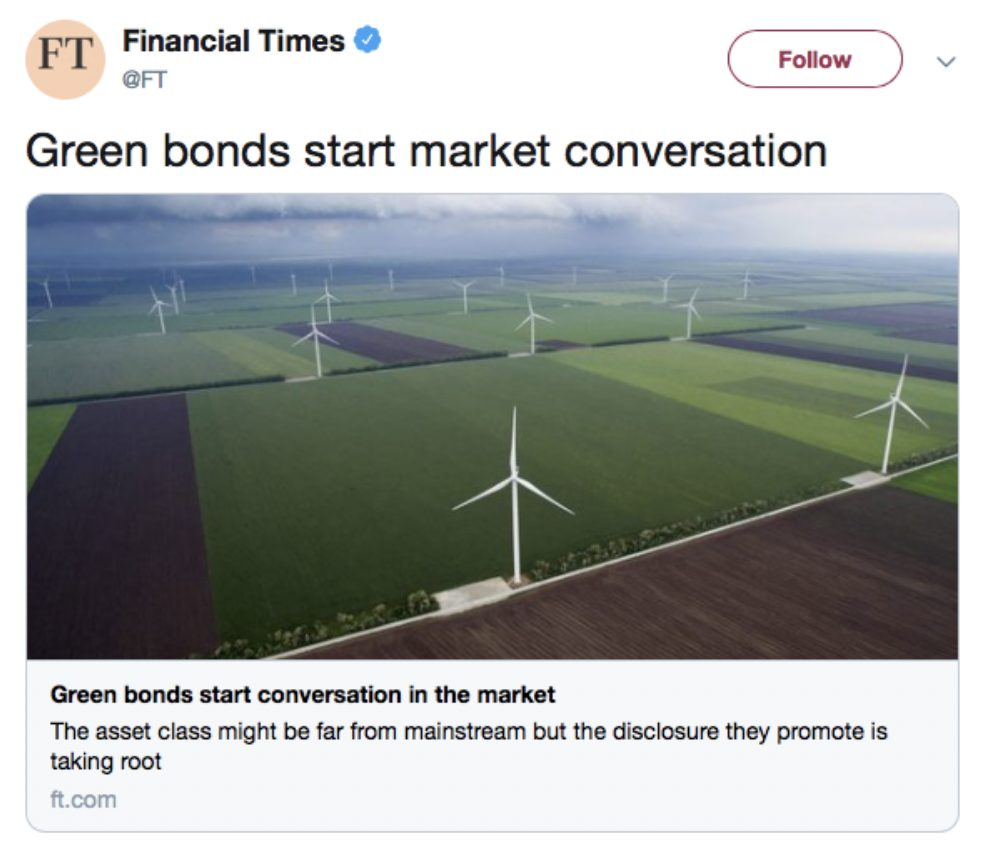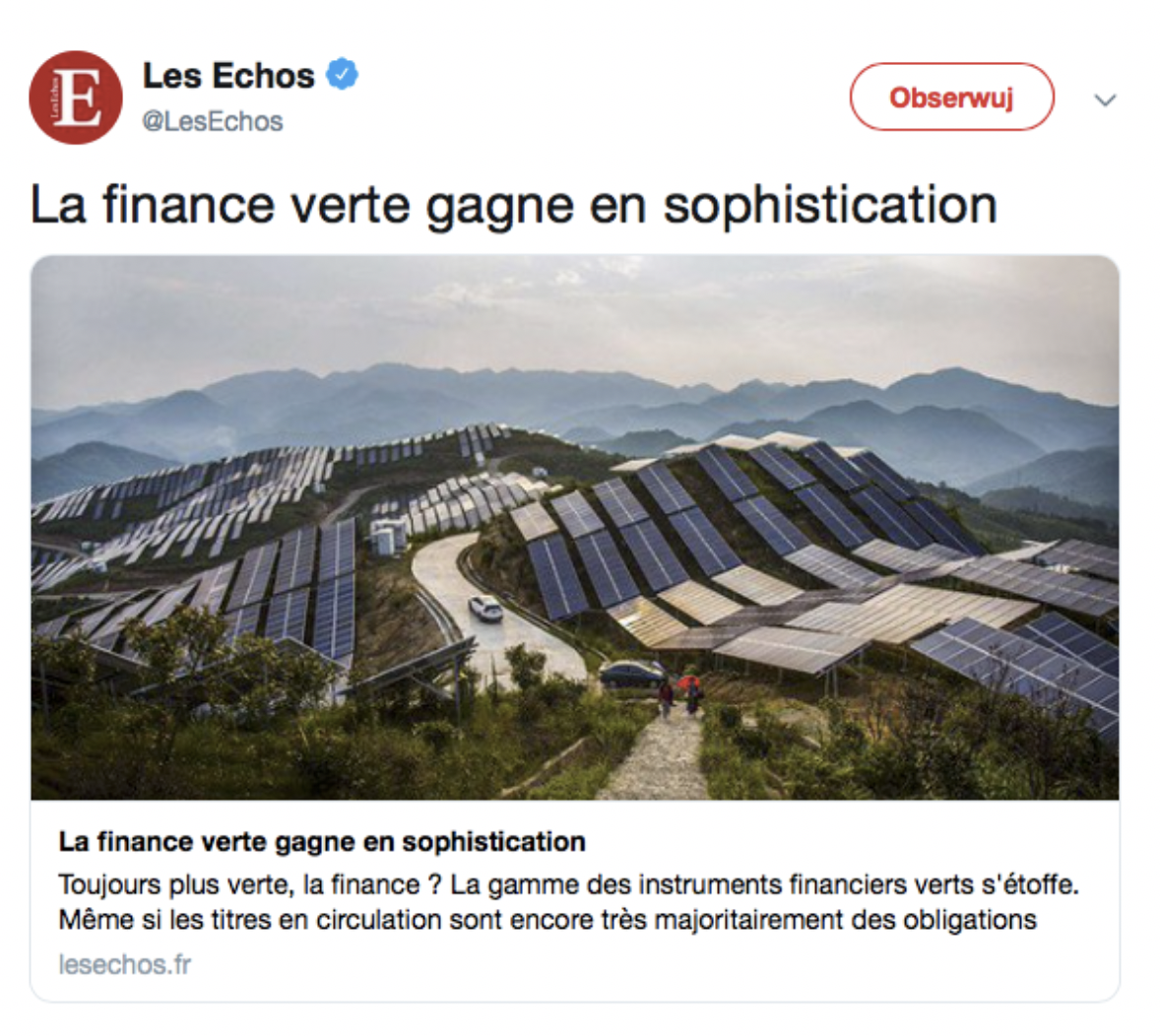MARKET NEWS
Financial Times, Greener tint to China project finance, Lucy Hornby
Journalist looks at how the landscape of Chinese green bonds market has been changing over the years. Her analysis puts an emphasis on how country-issued green bonds fulfil the international criteria set under the Climate Bonds Standard
Despite the international interest, China’s share of the world’s total of green bonds that meet standards set by the Climate Bonds Initiative, an international body, dropped to 12 per cent in the first half of this year, from 15 per cent in 2017 and almost 40 per cent in 2016. The banking sector accounted for just under half.
Financial Times, Green bonds start conversation in the market, Kate Allen
FT article suggests that although green bonds will never become mainstream, the influence they exert on the wider market cannot be underestimated.
“The green bond market is facilitating increased disclosure, which allows investors to have much more meaningful dialogue with issuers,” Mr Ghosh says [senior vice-president for environmental, social and governance and green bonds at Moody’s]. “So rather than the green bond market going mainstream, we will see it affecting the characteristics of the mainstream bond market.”
Financial Times, Lawyers set to work on the laws of nature, Madison Darbyshire
An interesting green bond market insight from the legal point of view.
As the market for green bonds and loans develops, legal definitions are shifting. Projects began as obviously green, says Anna-Marie Slot, a partner at Ashurst, but now “companies you wouldn’t typically think of as green are starting to want to issue green bonds because they want to become more green”. Since funds only have to make a company more green than before, lawyers must work out how to measure these improvements accurately.
Bloomberg, Security That Triggered a Recession Reworked to Green the Earth, Anna Hirtenstein and Sarah Husband
Authors explore the huge potential in securitizing bank loans for sustainable infrastructure.
In the U.S., securitization has already become a go-to funding source for rooftop-solar companies including Tesla Inc. and Vivint Solar Inc. More than $1.3 billion in solar asset-backed securities was raised last year alone, demonstrating that the U.S. residential solar industry became large enough for installers to monetize long-term consumer contracts by refinancing them in the capital markets.
Euromoney, Asia’s green investors and issuers lag global counterparts, Helen Avery
Securitization of green loans is also the main theme of the Euromoney article - here with a focus on South East Asia.
“The first phase in financing has mainly been green bonds, but now we need more alternatives – particularly for small and medium-sized enterprises, which are the locomotive of SE Asia,” he says [Mikkel Larsen, chief sustainability officer at DBS.]. “We need financial solutions that can ease some of the burdens and cost of green financing. Securitization may be one such possibility, although it is not without challenges.”
Observer Research Foundation, More innovation required for green bonds, Ayan Sharma
Author says that although massive strides have been made by the green bonds market in India, much more is needed to scale it. He lists creating national debt exchange, domestic certifying agency and stronger government support.
There is a lack of concentrated support measures for such a nascent instrument due to which investors still view them as high-risk investments. Financial structuring and securitisation could be used to lower risk and persuade investors otherwise. There are issues with sector diversification as well. Unconventional investment sectors such as marine conservation and forestry are yet to be breached.
Down to Earth Magazine, ’The Indian green bond market is a driver for people’, Priya Sreenivasan 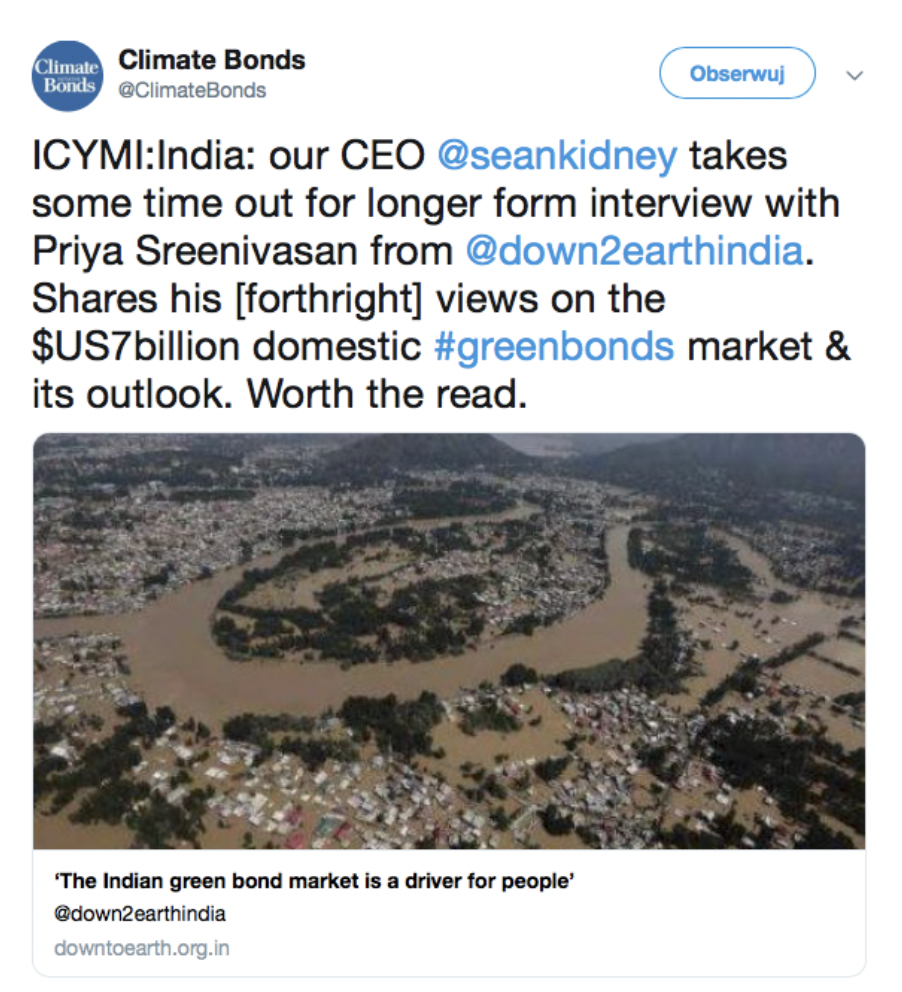
Sean Kidney spoke to the Indian magazine about accomplishments, challenges and weaknesses of the country’s green bonds market.
(…) according to the Institute and Faculty of Actuaries in the UK, these funds are likely to have their portfolios decimated by 2050. It is a very complicated agenda to recalibrate and account for long-term risk. For example, they should be putting a risk premium on every coal plant loan in India because those plants are going to go bankrupt by 2025.
Thomson Reuters Zawya, WGES 2018: Demand for green bonds outweighs standards concerns, says bank head, Michael Fahy
Reuters’ Middle East arm outlines an interesting discussion on regulation in the green bonds market that took place at World Green Economy Summit in Dubai.
The panelists agreed that standards, and even the language used, by issuers of green bonds in different parts of the world have developed differently, but Engin said that more cross-border funding was taking place in the green bonds market, "so I think more harmonisation in terms of taxonomies will be coming".
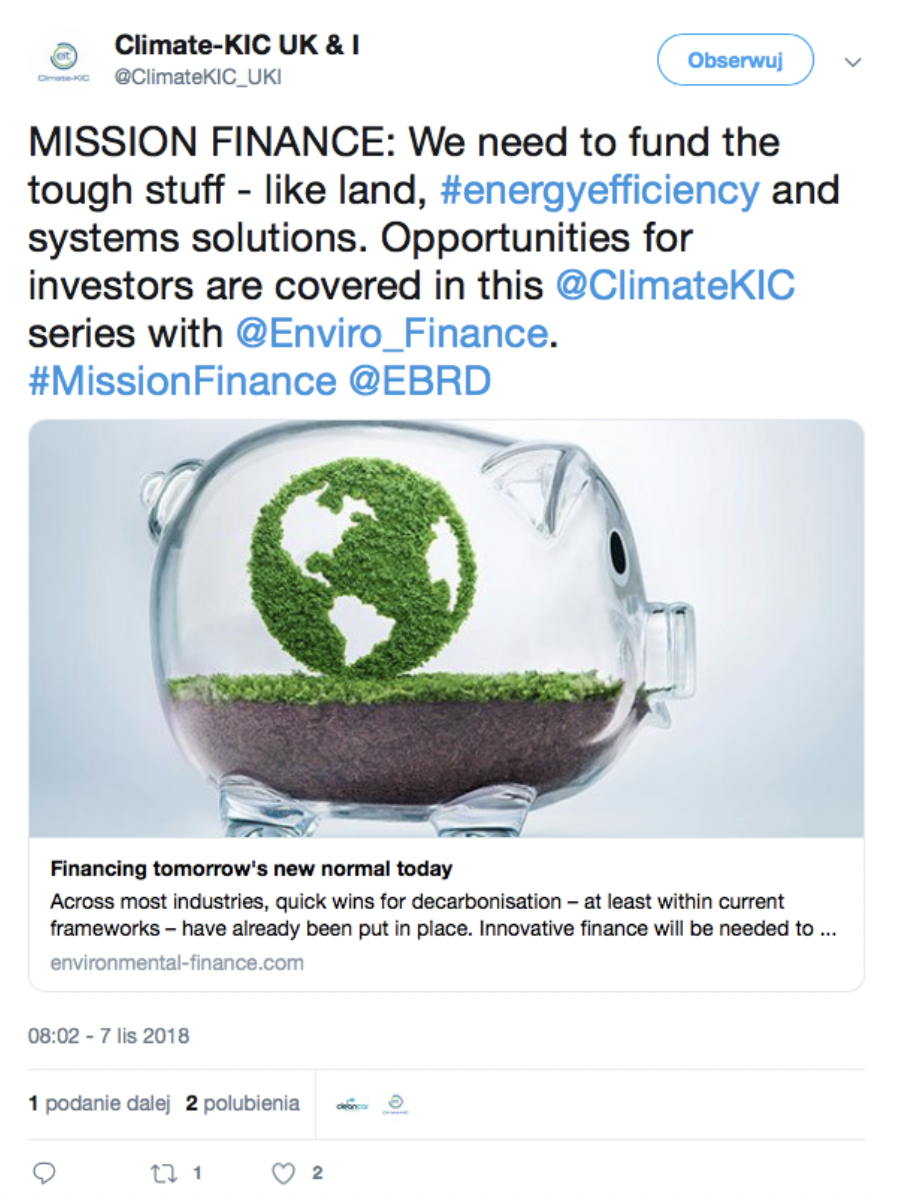 Environmental Finance, Financing tomorrow's new normal today
Environmental Finance, Financing tomorrow's new normal today
Most of the climate finance effort is currently channelled into energy infrastructure. Article stresses the need to unlock crucial investment in areas such as agriculture, sustainable land-use, energy efficiency retrofits and cities.
Agvesto, a technology company looking to enable better access to capital and climate risk protection into agricultural sector, is working with the Climate Bonds Initiative to establish "what areas we should be thinking about in agriculture and sustainable land-use and how to assess such bonds".
Environmental Finance, Opportunity awaits - Financing Asia's green buildings through green bonds
An in-depth analysis of how the market for green bonds that finance energy-efficient buildings is emerging in Asia-Pacific.
According to a recent Climate Bonds Initiative report, there is over 400 billion square meters of gross floor area globally – which is three times as large as New York State. These buildings account for roughly 30% of global final and 40% of primary energy consumption, roughly equal to 135 EJ of final energy.
Reuters, Private Capital Boosts Infrastructure Financing
The article quotes PwC report suggesting that “the appetite for private investment in infrastructure has never been stronger,” and explains how securitised deals and green bonds fit into that picture.
“What we’re observing is that there is a halo effect around green or sustainable projects,” says PwC’s Rathbone. “There are now real policies around growing the sustainability footprint. Businesses are looking at their networks and supply chains to make sure each part follows environmental guidelines. This means that companies are trying to build projects that involve green bond financing.”
Bloomberg Radio, U.S. Green Bond Issuance Lags Behind International: CBI
In an interview with Bloomberg radio, Andrew Whiley of the Climate Bonds Initiative explains why a lot of U.S. municipalities aren’t yet taking advantage of green bonds.
“There’re still questions around awareness. For many cities and utilities, there’re concerns that green bonds might require some extra cost and there isn’t yet a clear understanding that large institutional investors are looking for quality green products and many of the municipal sector products fit their requirements.”
The Bond Buyer, How climate change threatens to leave water bonds high and dry, Brooke Barton
Author, Senior Director of Water Programs at Ceres, calls on U.S. coast cities to prepare for climate impact and warns they will face downgrade on their bond ratings as the sea levels rise.
Another development that will shape the future of the municipal water bond market is the finalization of new water infrastructure criteria for green bonds. The new standard, which use specific scoring criteria to rank water projects on climate adaptation and environmental impacts, come as the green bond market is taking off globally, hitting a record $162 billion in 2017.
Eco-Business, Green bonds and green buildings—the perfect match?, Hannah Koh
Asian developers gathered at the International Green Building Conference explained how they benefited from issuing a green bond to finance portfolio retrofit. Benefits include huge energy bill savings, reaching new investors and reputation boost.
But the main reason for the biggest bank in Southeast Asia to get into green bonds—which it did in 2017—was to create new liquidity and reach new investors, he said. “The idea here is that by issuing a green bond, we would have an opportunity to speak to an investor group that would otherwise not even know about DBS. That, for us, was the primary reason.”
Nasdaq, Green bonds are fertile spot for climate activists, Antony Currie
Author, in simple terms, explains what “an increased disclosure” means when it comes to comparing green bonds to their vanilla equivalents.
Buyers of green debt are different. Companies and governments have to commit to use the proceeds only for specified purposes. That automatically gives bondholders more sway. Second, investors are increasingly demanding that companies provide enough information to ensure they're sticking to the agreement - much more than traditional creditors get.
The Bond Buyer, BAM launches GreenStar assessment to identify muni green bonds, Aaron Weitzman
Build American Mutual, a mutual bond insurance company that is an approved verified under the Climate Bonds Standard, introduces a muni green bonds assessment program.
BAM GreenStar designations will be available on qualifying BAM-insured bonds at no extra cost to the issuer. (…) Eligible projects include investments in sustainable water and wastewater systems, renewable energy and the construction or renovation of energy efficient buildings, among others.
CNBC, 'Green finance has moved from niche to mainstream'
BONDS AND CLIMATE CHANGE STATE OF THE MARKET 2018
The fifth edition of the annual State of the Market report identified 498 green bond issuers with USD389bn of outstanding bond volume. Read more on our blog and see media reports below.
Les Echos, La finance verte gagne en sophistication, Guillaume Benoit
La gamme des instruments financiers verts s'étoffe. (…) Au point de représenter plus d'un quart des 390 milliards de dollars des titres labellisés « verts », selon les estimations de la Climate Bond Initiative (CBI), qui vient de publier son rapport annuel, en collaboration avec HSBC.
Nikkei Asian Review, Green bonds take root in Southeast Asia, Mayuko Tani
A report by the nonprofit Climate Bonds Initiative says $155.5 billion was raised in the green bond market globally last year, up 78% increase from 2016. Growth continued this year, though at a slower pace of 4% on the year for the first half of 2018, the organization reported.
Markets Media, Europe Sets Standard For Corporate Sustainability, Shanny Basar
There are opportunities for more than $1.45 (€1.3) trillion of potential green bonds according to Climate Bonds Initiative’s latest annual analysis of labelled green bonds and wider climate-aligned bond universe. The Bonds and Climate – Change State of the Market 2018 study is sponsored by HSBC.
Energy Live News, US, China and France lead international green bond market, Jonny Bairstow
That’s the verdict from Climate Bonds’ latest analysis, which suggests the booming sector has room for “huge growth” into the 2020s, with more than $1.45 trillion (£1.1tn) of potential green bonds on offer.
Environmental Finance, Climate-aligned bonds now total $1.45trn, says CBI
The Climate Bonds Initiative (CBI) estimates that the total of 'climate-aligned' bonds outstanding is now about $1.45 trillion, of which $389 billion is in the form of labelled green bonds. The remainder consists of $747 billion of bonds from 'fully aligned' issuers and $314 billion from 'strongly aligned' issuers.
The Fifth Estate, Green building ratings are part of the drivers for Australia’s green bonds, Poppy Johnston
Presenting the Climate Bond Initiative’s research on the state of the global green bond and climate market on Wednesday morning in Sydney, Climate Bonds’ head of markets and report author Bridget Boulle said that the climate bond market was growing globally, including in the Asia Pacific region.
Business Green, London slips to third place in green finance rankings, Madeleine Cuff
According to the report, which looked at both labelled green bonds and bonds from issuers that derive the majority of their revenues from "climate-aligned" assets and green businesses, around $1.2tr of green or climate-aligned bonds were issued in 2018, up from just under $1.1tr in 2017.
HydroWorld, Report shows size of climate bonds market, how hydro fits, Elizabeth Ingram
According to the report, the top three fully-aligned issuers are Hydro-Quebec (Canada, US$13.8 billion), China Three Gorges (US$10.3 billion, including US$295 million of green bonds) and NHPC (India, US$6.1 billion).
Clean Technica, Green Bonds Issuance Crosses $100 Billion In 2018
The CBI recently released a report “Bonds and Climate Change – The State of the Market 2018” claiming that at the end of H1 2018, volume of outstanding ‘climate-aligned’ bonds was worth around $1.45 trillion. These bonds include those deriving 75-100% of their revenues from ‘green’ business lines and labelled green bonds.
Libre Mercado, Qué son los bonos verdes y cómo funcionan
España se ha sumado con ímpetu al carro de los bonos verdes. En 2017, la emisión de estos productos superó los 5.000 millones, según un informe de Climate Bonds gracias al creciente interés de empresas e instituciones.
Agence Ecofin, Les émissions d’obligations vertes ont dépassé 100 milliards $ sur les neuf premiers mois de 2018
En 2017, les émissions de ce genre d’obligations se sont établies à 155,5 milliards de dollars, ce qui représente une forte hausse par rapport aux 98 milliards de dollars émis en 2016, a-t-on ajouté de même source.
Le Matin Maroc, 389 milliards de dollars émis entre 2017 et le 2e trimestre 2018, Samir Benmalek
Sur les 1.450 milliards de dollars d'obligations émises dans la lutte contre le dérèglement climatiques, les obligations vertes ont représenté, entre 2017 et le 2e trimestre 2018, 389 milliards de dollars.
Future Today by Jeremy Leggett, $1.45 tn of labelled green bonds and climate-aligned bonds leaves “headroom for huge growth” into 2020s
The Climate Bonds Initiative puts a brave face on it, but the trend is grindingly linear, and given the imperatives, these new data reinforce recent posts on FutureToday showing the urgent need for green investment to accelerate.
United Nations Climate Change, Les obligations vertes: un marché au potentiel immense, selon un rapport
Le rapport phare de l'Initiative sur les Obligations climatiques, intitulé "Bonds and Climate Change State of the Market 2018", a été lancé lors du Forum Finance pour un Changement mondial de HSBC, l'un des premiers événements qui a marqué le début de la Semaine du climat de New York.
SDG Knowledge Hub (by IISD), Climate Bonds Initiative Report Calls for Increased Investment in Renewables to Implement SDGs, Paris Agreement, Leila Mead
According to the report, US$90 trillion of investment in climate projects is needed by 2030, and that to successfully combat climate change, global green finance must reach US$1 trillion by the end of 2020, and grow each year thereafter.
Green Buildings Council Australia, Green finance to fund our cities
(…) a recent report released by the Climate Bonds Initiative ranks Australia as “an example of world’s best practice” when it comes to developing a green bonds market for infrastructure and development.
Sustainable Stock Exchanges September 2018 Update
Climate Bonds Initiative’s flagship The State of the Market report was launched at HSBC’s Finance for Global Change Forum. The report provides an analysis of the labelled green bond climate-aligned and universe, highlighting investment opportunities to finance climate-aligned assets
IRELAND’S SOVEREIGN GREEN BOND
4th sovereign green bond to date was welcomed with heavy media interest. Few key pieces of coverage are listed below.
The Times, Green bond raises €3 billion, Paul O’Donoghue
Ireland has raised €3 billion in funding for renewable energy products through its first green bond, in a move which was greeted with enthusiasm by investors.
Irish Times, Investor orders hit €11.3bn in State’s first green bond sale, Joe Brennan
The National Treasury Management Agency (NTMA) received about €11.3 billion of orders from investors seeking to buy the Republic’s set of green bonds.
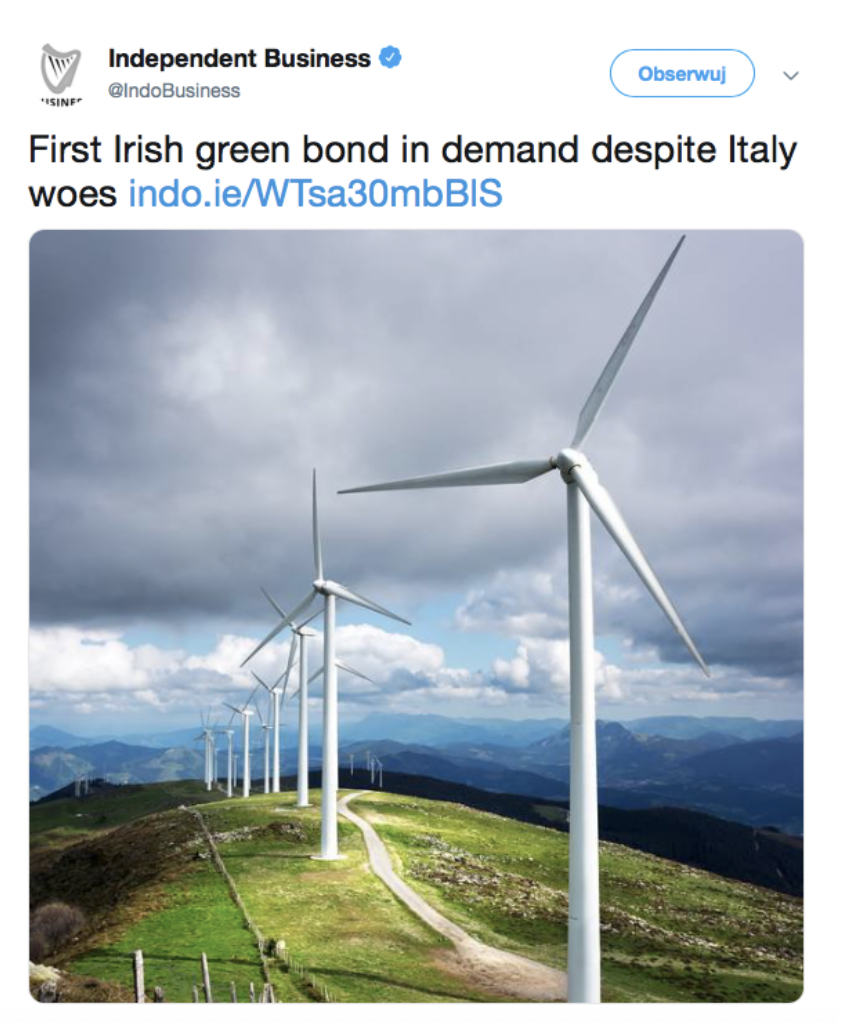 The Independent, First Irish green bond in demand despite Italy woes, David Chance
The Independent, First Irish green bond in demand despite Italy woes, David Chance
Ireland has become only the fourth country to issue a 'green' bond aimed at funding environmental investments.
Bloomberg, Five Things to Watch for in European Credit Markets This Week, Emma Haslett
Green bonds made up almost a quarter of primary market issuance by volume last week, with Ireland and Berlin Hyp AG among issuers piling in to a sector that’s become something of a safe play in a choppy market.
El Economista, Irlanda coloca 3.000 millones con su primer 'bono verde'
El Tesoro de Irlanda ha colocado este miércoles 3.000 millones de euros en la emisión de su primer 'bono verde' soberano a 12 años, según ha anunciado el Gobierno irlandés en un comunicado.
Reuters, Ireland could raise 2-3 bln euros from first "green bond"
Global green bond issuance hit a record $155.5 billion in 2017, surpassing previous estimates, and could reach $250 bln-$300 bln this year, research from the Climate Bonds Initiative (CBI) showed in January.
